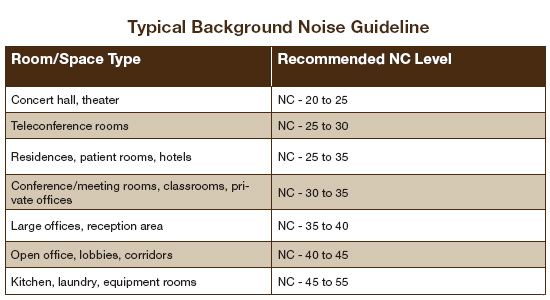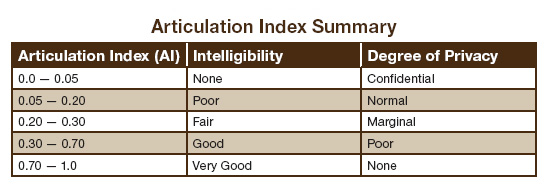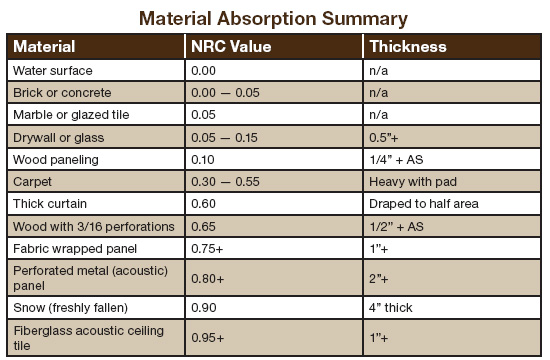Silence Is Golden
Background Noise
Background noise is often described using noise criteria (NC) curves, a series of octave-band curves defining acceptable sound pressure levels from 63 to 8,000 Hz. It is best to measure NC levels at occupant ear height at the loudest location in a space during ambient conditions. Background noise is typically governed by mechanical equipment and industry guidelines of acceptable levels as outlined by various organizations including ASHRAE (HVAC Applications 48.3).
Background noise guidelines are provided in the accompanying table. There is no universal agreement on background noise levels for each space because each project and customer is unique. Rather, the table presents a starting point to then adjust as appropriate. For reference, hearing-impaired occupants typically require NC curves that are at least 5 points below the criteria presented in the table.

Source: Price Industries
Another common method for describing continuous noise levels is to use the room criteria (RC) rating system, which provides additional background noise qualitative descriptions, such as hissy and rumbly. RC is more appropriate to diagnose mechanical noise, though it has increased in usage over the years especially among acoustical consultants.
Design guidelines do not always align with the realities of project conditions. Sometimes, well intentioned design criteria are too stringent and it is more important to align customer expectations with space shortcomings and usage. These discussions should take place early in the design process once the proposed space and needs are understood. For example, if the customer's current conference rooms have background noise levels of NC-40 that work to user satisfaction, it might not be necessary to achieve NC-25/30 in a new space. Generally, lower background noise levels correspond to higher project costs. In addition, the customer might actually be more satisfied with NC-35/40 and find NC-25/30 to be too quiet. Ultimately, customer needs should always trump what a generalized table indicates.
Duct Silencers
These products can help achieve specific background noise levels within occupied spaces. Duct silencers typically consist of perforated metal baffles that absorb noise. They come in various shapes (rectangular, elbows, circular, etc) and sizes, typically starting at 24 inches in length. Commercial applications typically utilize silencers with fiberglass-filled baffles, though some school and healthcare projects require that no fibrous media be exposed to the airstream. In these applications, either film-lined or packless silencers are used. Film-lined silencers have a polymer film between the acoustic media and airstream, which ensures that no fibrous media can enter the airstream. Packless silencers do not have acoustic media and instead employ tuned chambers to absorb noise. They are especially useful for airstreams with corrosive contaminants and high heat applications, and are often used for lab and industrial projects.
A general rule is to not place mechanical equipment adjacent to occupied space especially when noise levels of NC-40 and below are required. Today there are air moving devices that utilize integrated silencers with lab tested total assembly performance to ensure that sound sensitive spaces are not negatively impacted by their operation. These unique products should not be confused with typical air moving devices paired with a silencer, since system effects and generated noise are not properly accounted for and often result in elevated noise levels and reductions in energy efficiency.
Speech Privacy
Today's office has changed a great deal from 50 years ago. These days, open design concepts are commonplace and have often resulted in dissatisfied occupants. Many research findings and surveys support the various failures of open office design including reduced productivity. Research published in the British Journal of Psychology found that office workers were 66 percent less productive in an open-plan office than when left on their own.1 It should be no surprise that noise is the number one complaint with open office design and this is largely driven by the reduction in privacy, when compared to an office with walls. However well intentioned these open office formats are, the end result is clear—speech privacy has suffered greatly in today's open office world and is likely to continue for some time. Understanding the impact that office design has on speech privacy is important so that the client not only appreciates the aesthetics, but also how a space sounds.
The three aspects of noise discussed earlier apply to speech privacy as well—the source (talker), path (distance), and receiver (listener / unhappy worker). Speech intelligibility is often described using the Articulation Index (AI), which describes subjective speech intelligibility between a source (talker) and receiver (listener). AI varies between 0 (complete privacy) and 1 (no privacy). AI is inversely related to speech privacy—that is, low intelligibility means high privacy. Speech privacy in open plan offices is difficult to achieve because of the direct paths between occupants and raised occupant noise levels that often occur. In spaces where clear communication is crucial such as boardrooms and auditoriums, a high AI is desired. The accompanying table lists AI values and corresponding intelligibility and privacy descriptions for reference.

Source: Price Industries
Enclosed spaces typically have higher speech privacy than open spaces. The path's (walls, ceiling, doors, etc) ability to reduce noise transmission is typically limited by cracks and holes as described earlier. The total speech privacy between two enclosed spaces can be simply determined by adding background noise (NC) in the receiving space and field-measured acoustic separation (ASTC or NIC) between the two spaces.
Speech privacy between enclosed spaces illustrates the compromise between maintaining a low background noise level and the noise isolation required to achieve acceptable speech privacy. For example, conference rooms typically require low background noise levels (NC-25/30) and high speech privacy (SP 75+), which requires them to utilize higher noise isolation assemblies (STC-55+).
Sound Masking
One method of increasing speech privacy in open spaces is sound masking. It typically consists of speakers that produce a masking noise spectrum placed in the ceiling space. By raising the background noise level (NC), the speech privacy is increased. It is important to point out that privacy is increased over long distances (twenty feet or more), but not over short distances. That is to say, your noisy neighbor will still be noisy even with sound masking. Another common misperception is to use sound masking in private office and conference room spaces. This is often not needed, since walls should be designed to provide sufficient noise isolation. A single individual does not need speakers to increase privacy within an enclosed space since the walls do this. In a conference room, sound masking can have a negative effect by making it more difficult to understand individuals and interfering with audiovisual equipment. If used, it's worth discussing with the client and acoustical consultant so that expectations are aligned with the realities of sound masking.
Sound Absorption
Reverberation time indicates the amount of time for sound in a space to decay by 60 dB. In laymen's terms, it is the time needed for a sound to no longer be audible and is best measured in quiet environments without active mechanical equipment or other transient noise. Reverberation time should be tied to a space's intended function and often described at 500Hz. It is affected by the size of a room and the amount of absorption in a room. For example, learning spaces typically require shorter reverberation times (around 0.5 seconds) to allow for better speech intelligibility. Performance venues meanwhile typically require longer reverberation times (around 1.5 seconds), which result in spaces that sound richer and more full-bodied. One way to impact a space's reverberation time is by selecting surface treatments based on their sound absorption performance. An easy rule to remember is that by doubling the total amount of absorption in a room, the reverberation time is cut in half.
A material's ability to absorb noise is described in terms of its absorption coefficient, or α. A value of 0 indicates no absorption (complete reflection) and a value of 1 indicates complete absorption (no reflection). These coefficient values are typically determined using reverberation chambers by comparing the sound decay with and without the absorptive material in question. A common term used to describe a material's absorption performance is the noise reduction coefficient (NRC). The NRC is the arithmetic average of the sound absorption coefficients at 250, 500, 1000, and 2000Hz. This single number rating is rounded to the nearest multiple of 0.05 and is limited to describing mid-frequency absorption performance. Materials with NRC ratings above 0.5 are typically considered sound-absorbing, while materials with NRC ratings below 0.2 are considered sound-reflecting. The table lists NRC values for some common building materials and natural elements.

Source: Price Industries
It is worth mentioning that while acoustic ceiling tile (ACT) has a high NRC value, this is because the noise passes through (transmitted) and is captured in the space behind. An acoustic panel meanwhile can achieve NRC values that are just as high, but it does not allow noise to pass through because there is a solid outer casing as well. The important take away is that sound absorption (NRC) and noise isolation (STC) are not the same thing. Sound absorption is actually a combination of absorbed and transmitted energy, which can be a bit misleading for conditions where a large portion of the “absorption” is actually just transmitted energy. For example, an open window has a sound absorption coefficient of 1.0 because none of the noise is reflected back, but in reality the noise is all being transmitted and not actually absorbed. Noise isolation meanwhile describes how much sound is stopped. So it is common for many materials with high NRC values (absorption) to have very low noise isolation (STC) values. This is why it is best to use fiberglass ceiling tiles in open office spaces and mineral fiber tiles in private offices especially when offices do not have full height walls. The mineral fiber tiles reduce noise flanking through the plenum space because of their higher CAC values. The fiberglass tiles meanwhile “absorb” more noise and help improve speech privacy over longer distances in open office environments.









